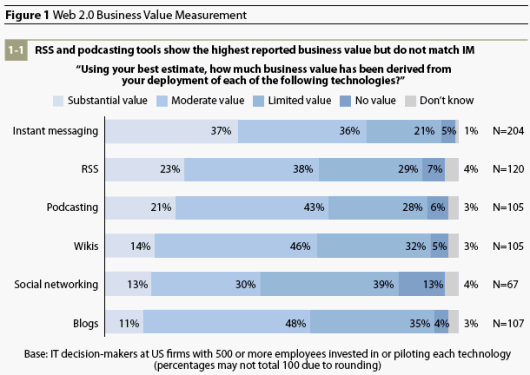Detailed Data Aside, Executives Back E2.0
A new market report, this time by McKinsey& Company, says a majority of executives say they plan to increase investments in technologies which fall under the collective hood of Enterprise and Web 2.0.
Like others before it, the report, "How businesses are using Web 2.0, a McKinsey Global Survey" provides good directional information (Executives support deployment of and investment in Enterprise 2.0 tools and technologies).
Joe McKendrick, Kevin Dugan (Strategic Public Relations), and others have taken nice approaches towards discussing the qualitative results and big-picture implications.
But, Blog Reader Beware, the data must be understood in the context of the survey and its methods. The survey data is from 2,847 executives worldwide, 44% of whom hold C-Level positions. What is unknown from the detail is whether multiple responses came from the same companies, and whether the executives themselves are fully aware their own technology pilots and production deployments.
As reported by Nicolas Carr, the Forrester report (a survey of CIOs) released earlier this year suggests 35% of companies are already using all 6 technologies covered in their report (including blogs, wikis, social networking, podcasts, RSS and Tagging). This is well above the 33% reported by McKinsey as already using or planning to use a wiki. Earlier this year, a study of the Inc. 500 reported that 19% have deployed blogs while 11% have deployed a wikis.
These deployment statistics are all over the map, but for good reason. The common problem with these studies is they don't define technology scope tightly enough and need to study rather than survey enterprises to verify the answers. For example, a "yes" answer to "Do you use social networking" may imply anything from "a given salesperson uses LinkedIn to find contacts" to "We deploy and rely upon a social networking system to augment our network directory." A Yes answer to a question about RSS may imply that a few employees use RSS readers, or that the company intranet employs RSS technology to syndicate information from internal blogs, their CRM and external news feeds.
I hope to see a study discriminate as to whether blogs are used externally or internally, whether wikis are instituted as part of a business process or whether the company deployed a tagging system on their Intranet. A study should select a representative sample set of companies and combine the viewpoints of many individuals, from Marketing to IT and the Executive Suite, to ensure that the whole truth is undestood, rather than one person's view of the their own deployments and their own interpretation of the technology terms in question.
The good news from the McKinsey data is a clear statement of enthusiasm, with 42% wishing they had strengthened their companies' internal capabilities to make the most of the opportunity and only 13% saying they've been dissatisfied with investments made thus far.
 The counsel these reports collectively provide is summarized well by a T-Shirt I owned as a youngster: Run with the Big Dogs, or Stay on the Porch. The Enterprise and Web 2.0 terms may come and go but the technologies shaping the intranets of tomorrow are here to today, and to stay.
The counsel these reports collectively provide is summarized well by a T-Shirt I owned as a youngster: Run with the Big Dogs, or Stay on the Porch. The Enterprise and Web 2.0 terms may come and go but the technologies shaping the intranets of tomorrow are here to today, and to stay.
 Forrester provided more grist for the data mill on this topic. The following chart and some detail on it was posted at Read/WriteWeb:
Forrester provided more grist for the data mill on this topic. The following chart and some detail on it was posted at Read/WriteWeb:
 I18N ERROR: @tsiskin#footer_RSS_Feed
I18N ERROR: @tsiskin#footer_RSS_Feed